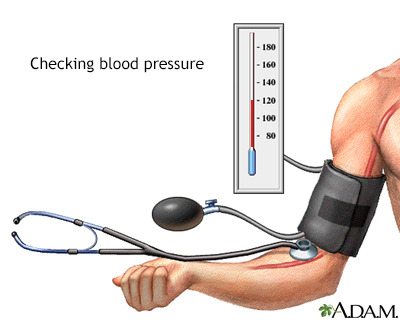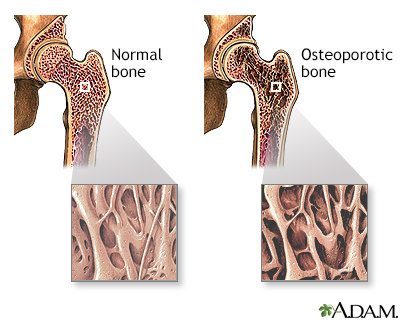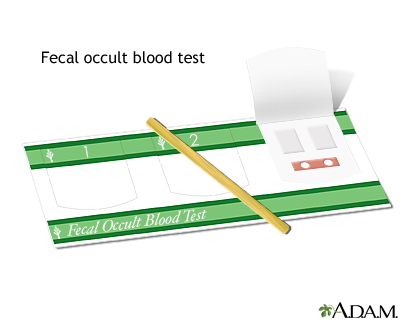Health screenings for men ages 40 to 64
You should visit your health care provider regularly, even if you feel healthy. The purpose of these visits is to:
- Screen for medical issues
- Assess your risk for future medical problems
- Encourage a healthy lifestyle
- Update vaccinations and other preventive care services
- Help you get to know your provider in case of an illness
Information
Even if you feel fine, you should still see your provider for regular checkups. These visits can help you avoid problems in the future. For example, the only way to find out if you have high blood pressure is to have it checked regularly. High blood sugar and high cholesterol level also may not have any symptoms in the early stages. Simple blood tests can check for these conditions.
High blood pressure
Blood pressure is a measurement of the force exerted against the walls of your arteries as your heart pumps blood to your body. Hypertension is the ...

High cholesterol
Cholesterol is a fat (also called a lipid) that your body needs to work properly. Too much bad cholesterol in your blood can increase your chance of...

There are specific times when you should see your provider or receive specific health screenings. The US Preventive Services Task Force publishes a list of recommended screenings. Below are screening guidelines for men ages 40 to 64.
BLOOD PRESSURE SCREENING
Have your blood pressure checked at least once every year. Watch for blood pressure screenings in your area. Ask your provider if you can stop in to have your blood pressure checked.
Blood pressure
Blood pressure is a measurement of the force on the walls of your arteries as your heart pumps blood through your body. You can measure your blood pr...

Ask your provider if you need your blood pressure checked more often if:
- You have diabetes, heart disease, kidney problems, or are overweight or have certain other health conditions
Heart disease
Coronary heart disease is a narrowing of the blood vessels that supply blood and oxygen to the heart. Coronary heart disease (CHD) is also called co...
 ImageRead Article Now Book Mark Article
ImageRead Article Now Book Mark ArticleKidney problems
Chronic kidney disease is the slow loss of kidney function over time. The main job of the kidneys is to remove wastes and excess water from the body...
 ImageRead Article Now Book Mark Article
ImageRead Article Now Book Mark Article - You have a first-degree relative with high blood pressure
- You are Black
- Your blood pressure top number is from 120 to 129 mm Hg, or the bottom number is from 70 to 79 mm Hg
If the top number is 130 mm Hg or greater or the bottom number is 80 mm Hg or greater, this is considered stage 1 hypertension. Schedule an appointment with your provider to learn how you can lower your blood pressure.

Effects of age on blood pressure
Blood vessels become less elastic with age. The average blood pressure increases from 120/70 to 150/90 and may persist slightly high even if treated. The blood vessels respond more slowly to a change in body position.
CHOLESTEROL SCREENING
Cholesterol screening should begin at age 35 for men with no known risk factors for coronary heart disease.
Cholesterol screening
Cholesterol is a soft, wax-like substance found in all parts of the body. Your body needs a little bit of cholesterol to work properly. But too muc...

Repeat cholesterol screening should take place:
- Every 5 years for men with normal cholesterol levels
- More often if changes occur in lifestyle (including weight gain and diet)
- More often if you have diabetes, heart disease, kidney problems, or certain other conditions
COLORECTAL CANCER SCREENING
If you are under age 45, talk to your provider about getting screened. You may need to be screened if you have a strong family history of colon cancer or polyps. Screening may also be considered if you have risk factors such as a history of inflammatory bowel disease or polyps.
Screened
Colon cancer screening can detect polyps and early cancers in the large intestine. This type of screening can find problems that can be treated befo...

If you are age 45 to 75, you should be screened for colorectal cancer. There are several screening tests available:
Colorectal cancer
Colorectal cancer is cancer that starts in the large intestine (colon) or the rectum (end of the colon). It is also sometimes simply called colon ca...

- A stool-based fecal occult blood (gFOBT) or fecal immunochemical test (FIT) every year
FIT
The fecal immunochemical test (FIT) is used as a screening test for colon cancer. It tests for hidden blood in the stool, which can be an early sign...
Read Article Now Book Mark Article - A stool sDNA test every 1 to 3 years
- Flexible sigmoidoscopy every 5 years or every 10 years with stool testing FIT done every year
Sigmoidoscopy
Sigmoidoscopy is a procedure used to see inside the sigmoid colon and rectum. The sigmoid colon is the area of the large intestine nearest to the re...
 ImageRead Article Now Book Mark Article
ImageRead Article Now Book Mark Article - CT colonography (virtual colonoscopy) every 5 years
Virtual colonoscopy
Virtual colonoscopy (VC) is an imaging or x-ray test that looks for cancer, polyps, or other disease in the large intestine (colon). The medical nam...
 ImageRead Article Now Book Mark Article
ImageRead Article Now Book Mark Article -
Colonoscopy every 10 years
Colonoscopy
A colonoscopy is an exam that views the inside of the colon (large intestine) and rectum, using a tool called a colonoscope. The colonoscope has a sm...
 ImageRead Article Now Book Mark Article
ImageRead Article Now Book Mark Article
You may need a colonoscopy more often if you have risk factors for colorectal cancer, such as:
-
Ulcerative colitis
Ulcerative colitis
Ulcerative colitis is a condition in which the lining of the large intestine (colon) and rectum become inflamed. It is a form of inflammatory bowel ...
 ImageRead Article Now Book Mark Article
ImageRead Article Now Book Mark Article - A personal or family history of colorectal cancer
- A history of growths in your colon called adenomatous polyps
Adenomatous polyps
A colorectal polyp is a growth on the lining of the colon or rectum.
 ImageRead Article Now Book Mark Article
ImageRead Article Now Book Mark Article
DENTAL EXAM
- Go to the dentist once or twice every year for an exam and cleaning. Your dentist will evaluate if you have a need for more frequent visits.
DIABETES SCREENING
- All adults who do not have risk factors for diabetes should be screened starting at age 35 and repeated every 3 years.
Diabetes
Diabetes is a long-term (chronic) disease in which the body cannot regulate the amount of sugar in the blood.
 ImageRead Article Now Book Mark Article
ImageRead Article Now Book Mark Article - If you have other risk factors for diabetes, such as a first degree relative with diabetes, overweight or obesity, high blood pressure, prediabetes, or a history of heart disease, you may be tested more often.
- If you are overweight and have other risk factors, such as high blood pressure and are planning to become pregnant, screening is recommended.
EYE EXAM
- Have an eye exam every 2 to 4 years ages 40 to 54 and every 1 to 3 years ages 55 to 64. Your provider may recommend more frequent eye exams if you have vision problems or glaucoma risk.
Glaucoma
Glaucoma is a group of eye conditions that can damage the optic nerve. This nerve sends the images you see to your brain. Most often, optic nerve da...
 ImageRead Article Now Book Mark Article
ImageRead Article Now Book Mark Article - Have an eye exam that includes an examination of your retina (back of your eye) at least every year if you have diabetes.
IMMUNIZATIONS
Commonly needed vaccines include:
-
Flu shot: get one every year
Flu
The flu (influenza) is a viral respiratory illness that causes fever, chills, runny nose, body aches, and cough. It spreads easily from person to pe...
 ImageRead Article Now Book Mark Article
ImageRead Article Now Book Mark Article - COVID-19 vaccine: ask your provider what is best for you
- Tetanus-diphtheria and acellular pertussis (Tdap) vaccine: have as one of your tetanus-diphtheria vaccines if you did not receive it as an adolescent
- Tetanus-diphtheria: have a booster (or Tdap) every 10 years
- Varicella vaccine: receive 2 doses if you never had chickenpox or the varicella vaccine and were born in 1980 or after
- Hepatitis B vaccine: receive 2, 3, or 4 doses, depending on your exact circumstances, if you did not receive these as a child or adolescent, until age 59
- Shingles (herpes zoster) vaccine: at or after age 50
Ask your provider if you should receive other immunizations, especially if you have certain medical conditions, such as diabetes or are at increased risk for some diseases such as pneumonia.
INFECTIOUS DISEASE SCREENING
Screening for hepatitis C: all adults ages 18 to 79 should get a one-time test for hepatitis C.
Hepatitis C
Hepatitis C is a viral disease that leads to swelling (inflammation) of the liver. Other types of viral hepatitis include:Hepatitis AHepatitis BHepat...

Screening for human immunodeficiency virus (HIV): all people ages 15 to 65 should get a one-time test for HIV.
HIV
Human immunodeficiency virus (HIV) is the virus that causes acquired immunodeficiency syndrome (AIDS). When a person becomes infected with HIV, the ...

Depending on your lifestyle and medical history, you may need to be screened for infections such as syphilis, chlamydia, and other infections.
LUNG CANCER SCREENING
You should have an annual screening for lung cancer with low-dose computed tomography (LDCT) if:
Lung cancer
Lung cancer is cancer that starts in the lungs. The lungs are located in the chest. When you breathe, air goes through your nose, down your windpipe...
Read Article Now Book Mark Article- You are age 50 to 80 years AND
- You have a 20 pack-year smoking history AND
- You currently smoke or have quit within the past 15 years
OSTEOPOROSIS SCREENING
- If you are age 50 to 64 and have risk factors for osteoporosis, you should discuss screening with your provider.
Osteoporosis
Osteoporosis is a disease in which bones become fragile and more likely to break (fracture).
 ImageRead Article Now Book Mark Article
ImageRead Article Now Book Mark Article - Risk factors can include long-term steroid use, low body weight, smoking, heavy alcohol use, having a fracture after age 50, or a family history of hip fracture or osteoporosis.

Osteoporosis
Osteoporosis is a condition characterized by progressive loss of bone density, thinning of bone tissue and increased vulnerability to fractures. Osteoporosis may result from disease, dietary or hormonal deficiency or advanced age. Regular exercise and vitamin and mineral supplements can reduce and even reverse loss of bone density.
PHYSICAL EXAM
All adults should visit their provider from time to time, even if they are healthy. The purpose of these visits is to:
- Screen for diseases
- Assess risk of future medical problems
- Encourage a healthy lifestyle
- Update vaccinations and other preventive care services
- Maintain a relationship with a provider in case of an illness
Your height, weight, and body mass index (BMI) should be checked at every exam.
Body mass index (BMI)
A good way to decide if your weight is healthy for your height is to figure out your body mass index (BMI). You and your health care provider can us...

During your exam, your provider may ask you about:
-
Depression and anxiety
Depression
Depression may be described as feeling sad, blue, unhappy, miserable, or down in the dumps. Most of us feel this way at one time or another for shor...
 ImageRead Article Now Book Mark Article
ImageRead Article Now Book Mark Article - Diet and exercise
- Alcohol and tobacco use
- Safety, such as use of seat belts and smoke detectors
- Your medicines and risk for interactions
PROSTATE CANCER SCREENING
If you're 55 through 69 years old, before having the test, talk to your provider about the pros and cons of having a PSA test. Ask about:
PSA
Prostate-specific antigen (PSA) is a protein produced by prostate cells. The PSA test is done to help screen for and monitor prostate cancer in men....

-
Whether screening decreases your chance of dying from prostate cancer.
Prostate cancer
Prostate cancer is cancer that starts in the prostate gland. The prostate is a small, walnut-shaped structure that makes up part of a man's reproduc...
 ImageRead Article Now Book Mark Article
ImageRead Article Now Book Mark Article - Whether there is any harm from prostate cancer screening, such as side effects from testing or overtreatment of cancer when discovered.
- Whether you have a higher risk of prostate cancer than others.
If you are age 55 or younger, screening is not generally recommended. You should talk with your provider about if you have a higher risk for prostate cancer. Risk factors include:
- Having a family history of prostate cancer (especially a brother or father)
- Being African American
- If you choose to be tested, the PSA blood test is repeated over time (yearly or less often), though the best frequency is not known.
- Prostate examinations are no longer routinely done on men with no symptoms.

Prostate cancer
Prostate cancer is the most common cancer in men in the United States. Prostate cancer forms in the prostate gland, and can sometimes be felt on digital rectal examination. This is one of the purposes of the digital rectal exam.
SKIN EXAM
- Your provider may check your skin for signs of skin cancer, especially if you're at high risk. People at high risk include those who have had skin cancer before, have close relatives with skin cancer, or have a weakened immune system.
Skin cancer
Squamous cell skin cancer is the second most common type of cancer in the United States. Other common types of skin cancer are:Basal cell cancerMelan...
 ImageRead Article Now Book Mark Article
ImageRead Article Now Book Mark Article
TESTICULAR EXAM
- The US Preventive Services Task Force (USPSTF) now recommends against performing testicular self-exams. Doing testicular self-exams has been shown to have little to no benefit.
Reviewed By
David C. Dugdale, III, MD, Professor of Medicine, Division of General Medicine, Department of Medicine, University of Washington School of Medicine. Also reviewed by David Zieve, MD, MHA, Medical Director, Brenda Conaway, Editorial Director, and the A.D.A.M. Editorial team. Editorial update 04/18/2023. Internal review and update on 08/01/23.
Advisory Committee on Immunization Practices. Recommended immunization schedule for adults aged 19 years or older, United States, 2023. www.cdc.gov/vaccines/schedules/hcp/imz/adult.html. Updated April 17, 2023. Accessed July 30, 2023.
American Academy of Ophthalmology website. Clinical statement: Comprehensive adult medical eye examination PPP 2020. www.aao.org/education/preferred-practice-pattern/comprehensive-adult-medical-eye-evaluation-ppp. Updated November 2020. Accessed July 30, 2023.
American Dental Association website. Your top 9 questions about going to the dentist - answered! www.mouthhealthy.org/en/dental-care-concerns/questions-about-going-to-the-dentist. Accessed July 30, 2023.
Atkins D, Barton M. The periodic health examination. In: Goldman L, Schafer AI, eds. Goldman-Cecil Medicine. 26th ed. Philadelphia, PA: Elsevier; 2020:chap 12.
ElSayed NA, Aleppo G, Aroda VR, American Diabetes Association, et al. American Diabetes Association 2. Classification and diagnosis of diabetes: standards of medical care in diabetes-2023. Diabetes Care. 2023;46(Suppl 1):S19-S30. PMID: 36507649. PMID: 34964875 pubmed.ncbi.nlm.nih.gov/36507649/.
Grundy SM, Stone NJ, Bailey AL, et al. 2018 AHA/ACC/AACVPR/AAPA/ABC/ACPM/ADA/AGS/APhA/ASPC/NLA/PCNA Guideline on the management of blood cholesterol: a report of the American College of Cardiology/American Heart Association Task Force on Clinical Practice Guidelines [published correction appears in J Am Coll Cardiol. 201925;73(24):3237-3241]. J Am Coll Cardiol. 2019;73(24):e285-e350. PMID: 30423393 pubmed.ncbi.nlm.nih.gov/30423393/.
Meschia JF, Bushnell C, Boden-Albala B, et al. Guidelines for the primary prevention of stroke: a statement for healthcare professionals from the American Heart Association/American Stroke Association. Stroke. 2014;45(12):3754-3832. PMID: 25355838 pubmed.ncbi.nlm.nih.gov/25355838/.
Mora S, Libby P, Ridker PM. Primary prevention of cardiovascular disease. In: Libby P, Bonow RO, Mann DL, Tomaselli GF, Bhatt DL, Solomon SD, eds. Braunwald's Heart Disease: A Textbook of Cardiovascular Medicine. 12th ed. Philadelphia, PA: Elsevier; 2022:chap 25.
US Preventive Services Task Force website. A and B recommendations. www.uspreventiveservicestaskforce.org/uspstf/recommendation-topics/uspstf-a-and-b-recommendations. Accessed July 30, 2023.
US Preventive Services Task Force website. Final recommendation statement. Colorectal cancer: screening. www.uspreventiveservicestaskforce.org/uspstf/recommendation/colorectal-cancer-screening. Published May 18, 2021. Accessed July 30, 2023.
US Preventive Services Task Force website. Final recommendation statement. Hepatitis C virus infection in adolescents and adults: screening. www.uspreventiveservicestaskforce.org/uspstf/recommendation/hepatitis-c-screening. Published March 2, 2020. Accessed July 30, 2023.
US Preventive Services Task Force website. Final recommendation statement. Human immunodeficiency virus (HIV) infection: Screening. www.uspreventiveservicestaskforce.org/uspstf/recommendation/human-immunodeficiency-virus-hiv-infection-screening. Published June 11, 2019. Accessed July 30, 2023.
US Preventive Services Task Force website. Final recommendation statement: lung cancer: screening. www.uspreventiveservicestaskforce.org/uspstf/recommendation/lung-cancer-screening. Updated March 9, 2021. Accessed July 30, 2023.
US Preventive Services Task Force website. Final recommendation statement: osteoporosis to prevent fracture: screening. www.uspreventiveservicestaskforce.org/uspstf/recommendation/osteoporosis-screening. Updated June 26, 2018. Accessed July 30, 2023.
US Preventive Services Task Force website. Final recommendation statement. Prostate cancer: screening. www.uspreventiveservicestaskforce.org/uspstf/recommendation/prostate-cancer-screening. Updated May 8, 2018. Accessed July 30, 2023.
US Preventive Services Task Force website. Hypertension in adults: screening. www.uspreventiveservicestaskforce.org/uspstf/recommendation/hypertension-in-adults-screening. Published April 27, 2021. Accessed July 30, 2023.
US Preventive Services Task Force website. Prediabetes and type 2 diabetes: Screening. www.uspreventiveservicestaskforce.org/uspstf/recommendation/screening-for-prediabetes-and-type-2-diabetes. Updated August 24, 2021. Accessed July 30, 2023.
US Preventive Services Task Force website. Skin cancer: screening. www.uspreventiveservicestaskforce.org/uspstf/recommendation/skin-cancer-screening. Updated April 18, 2023. Accessed July 30, 2023.
US Preventive Services Task Force website. Testicular cancer: screening. www.uspreventiveservicestaskforce.org/uspstf/recommendation/testicular-cancer-screening. Published April 15, 2011. Accessed July 30, 2023.
Whelton PK, Carey RM, Mancia G, Kreutz R, Bundy JD, Williams B. Harmonization of the American College of Cardiology/American Heart Association and European Society of Cardiology/European Society of Hypertension Blood Pressure/Hypertension Guidelines: Comparisons, Reflections, and Recommendations. Circulation. 2022;146:868–877. DOI: 10.1161/CIRCULATIONAHA.121.054602. PMID: 35950927. pubmed.ncbi.nlm.nih.gov/35950927/.
Disclaimer



 All rights reserved.
All rights reserved.